Today we finish up with a final gallery of fabulous fish from my February 2024 online class a—Quilter’s Fantastical Trophy Fish—including “Gone Fishing” (photo above), by Judy Schryver.
While I knew I liked fish as a subject for fabric collage and that they were great as a way to introduce the technique, I wasn’t sure how enthusiastic students would be about them. Turns out I shouldn’t have worried. The February class was met with lots of energy and enthusiasm. So much so, that I decided to turn the recordings of that class into an eWorkshop!
As subjects for fabric collage, fish are a great choice since there are as many ways to interpret a fish as there are fish in the sea. This is true for both beginners—looking for an easy, low-stress subject to learn the technique—or for experienced quilters—who may want to loosen up and just have fun playing with fabric.
NOW AVAILABLE!
Susan Carlson Fabric Collage: Fantastical Fish eWorkshop
INCLUDES:
• All four recordings from the four-week class.
• Extended 10-minute edition of piecing time lapse (see below).
• Over six hours of video instruction.
• Annotated videos with “jump points” to help find the information you need.
• Materials list
• Links to helpful blog posts of information.
• Free fish pattern of your choice.
Today’s post shows off the “tail-end” of the fishy submissions created during the original month-long class—I have loved them all!—including your stories! Most of the collages are still in progress, but the vibrancy of color and richness of pattern are already on full display.
To ooggle more of the fanciful February Fish specimens, please click on these links: Fantastical Fish—Part 1, More Fish in the Sea—Part 2, Even More Fish—Part 3.
A final thanks (for now) to all the participants of our month of Quilter’s Fantastical Trophy Fish. You inspired me in turn with your own creativity and comments. I knew you were out there, waiting for the next installment, and it pushed me to bring as much energy and color as possible to brighten up an otherwise monochromatic winter.
Learning resources referred to in this post include: Serendipity Quilts, Spiral eWorkshop, Facial Features eWorkshop, Fabric Collage Master Class, 5-day online Zoom classes, and my patterns (including fish and sun/moon patterns).
Click on any of the smaller images below to view them larger.
Noreen Duncan
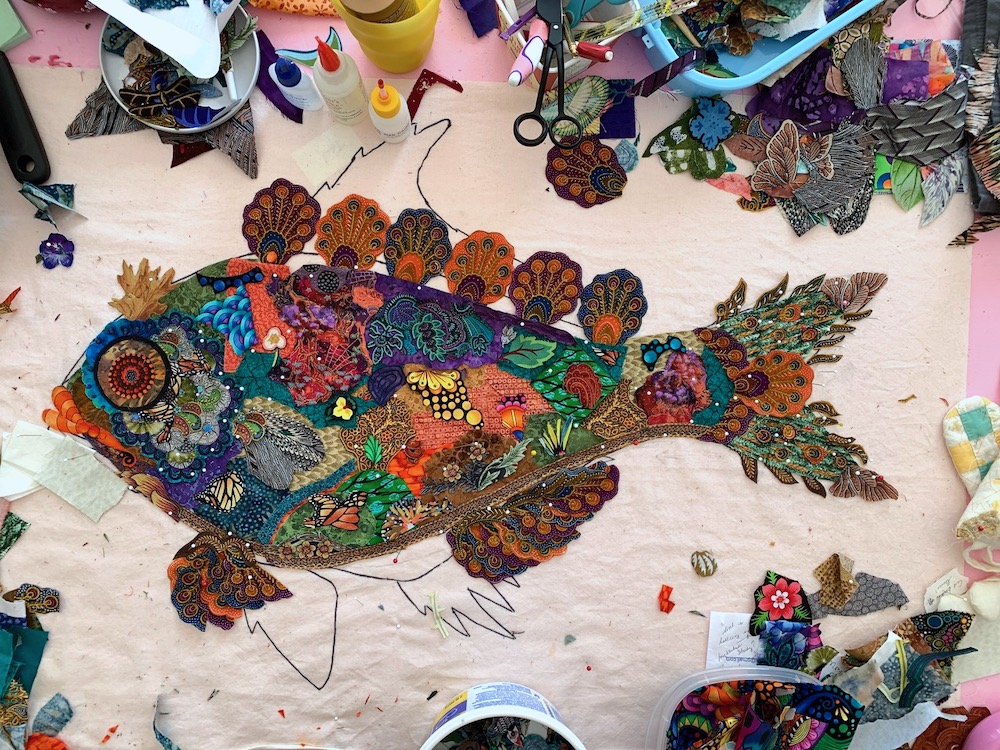
From Noreen Duncan of Winnipeg, Manitoba, Canada:
About 10 years ago, a friend inspired me to create a Susan Carlson fish, as in book “Free-Style Quilts”- A ‘No Rules’ Approach (C & T 2000). I bought the book, and began following Susan on-line. It has been interesting to watch as her techniques changed and become even more free-flowing, creative, and ‘awe-some’. I have been part of several on-line techniques classes, plus more recently “Thursday Night in my Studio” and “Fly on the Wall” sessions. Unfortunately, since late 2020, life and health issues stalled me, and I haven’t been able to do the hands-on creative work I had dreamed of. Of course, like all registrants, how lucky I am (hope to be) to be able to re-view those previous class videos, and my Master Class manual, and to refer back to them now – i.e. assuming I can locate them all !?! (Tip for new followers: File resources promptly and carefully! And, back them up!)
“Amélie” is my Draft # 1.5 from the fabulous four-session “Fantastical Trophy Fish” on-line class with Susan. Note that, Susan’s ‘no rules’ approach meant I was free to create my own fish, vs staying within the pattern lines. Before Amélie will be complete, I still have lots of work to do. … fussy cutting, gluing, adding many embellishments, auditioning where and to what extent I want to add tulle, netting, or opaque/sheer fabrics, and specialty features like glitters. … choosing fabrics and carefully planning a background for Amélie. … Then will come layering, quilting, binding, etc. (… For all of these features, Susan shared many ideas, and demos – which I can review in the videos of our classes!) ) At a magnification of 300% [of Susan’s pattern print-out], this is the largest fabric collage piece I have worked on, Because I won’t get more done on Amélie before the deadline of submission of “Trophy Fish” photos, I send this “after Class 1 homework” photo. I especially look forward to seeing photos from classmates whose fish are further along in the process than mine is.
What I learned most from this class:
- Get the pattern covered. Don’t fuss over the head or any one fin… you will change it anyway! Just get it done.
- Embellishments and add-ons need as much time and attention as getting the fish covered initially.
- The background is as important to consider and plan for as as it is for the fish itself.
- Remember to review class and enrichment resource videos.
- As you’ve been following on-line, and are confident Susan’s classes are well planned and her teaching methodology is easy to follow, Susan and Tom are likely to add new facets that raise the bar even higher. eg. slide show dealing with fabric choices, warp speed video of Susan getting her demo fish covered with fabric, and the on-going and spontaneous additions of new and useful tips and techniques. e.g. re- gluing.
Judy Schryver
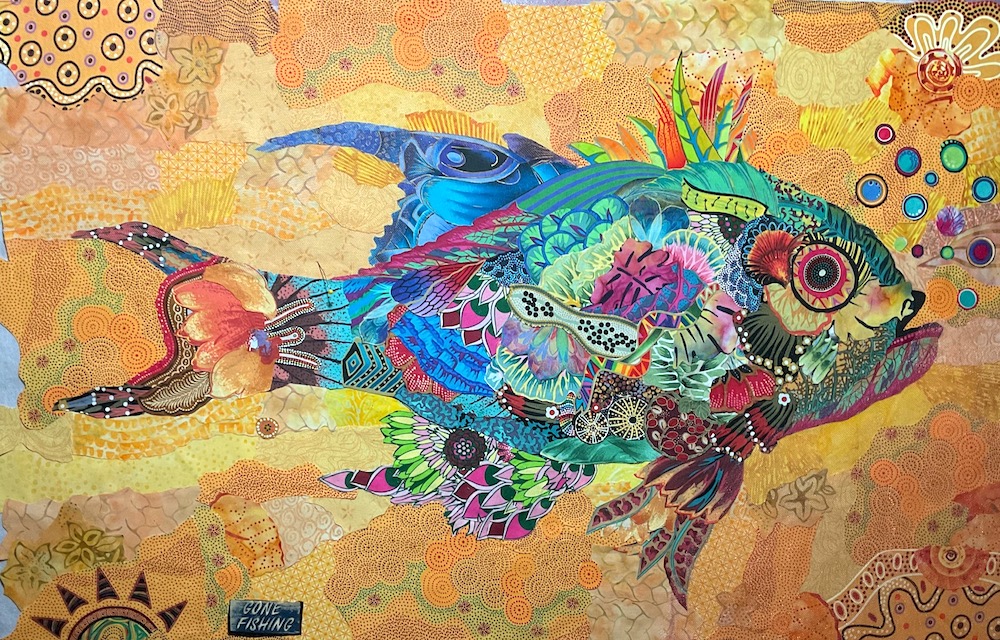
From Judy Schryver from Lockport New York:
I finished my homework every week. This is my first time creating a pieced background. Did many changes. Tried netting over the background. Of them all a pink netting will be used in some places. It is not done in the photo. Can’t wait to finish!
Kathleen Murphy
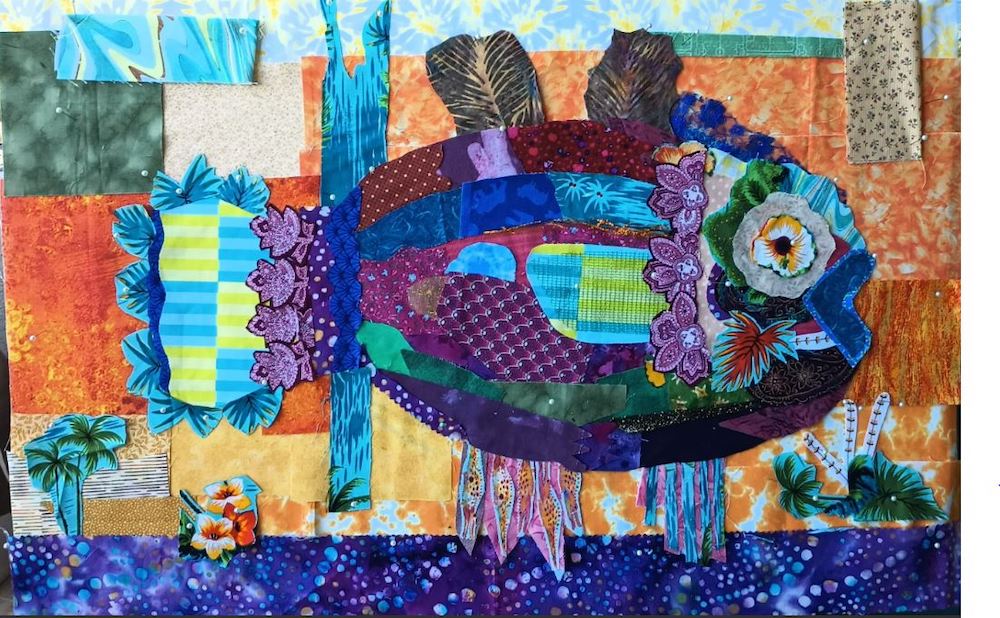
From Kathleen Murphy of Tucson, AZ:
This fish quilt was inspired by the pattern “Fan Fin” in the book “Free Style Quilts,: which I have been attempting for years. There are also several inspiring photos of fish in process and student work. I was relieved to learn now that I did not have to cut out all those individual pattern pieces to the fish, just use it as a guide.
One thing I learned is that the tacky glue is super strong and a little is plenty. Also, that we should NEVER glue the edges of anything until the very end, as some other fabric will probably need to slip under it. At this time, I am still putting together the quilt sandwich and need to free motion quilt and hang.
Maribel Marrero
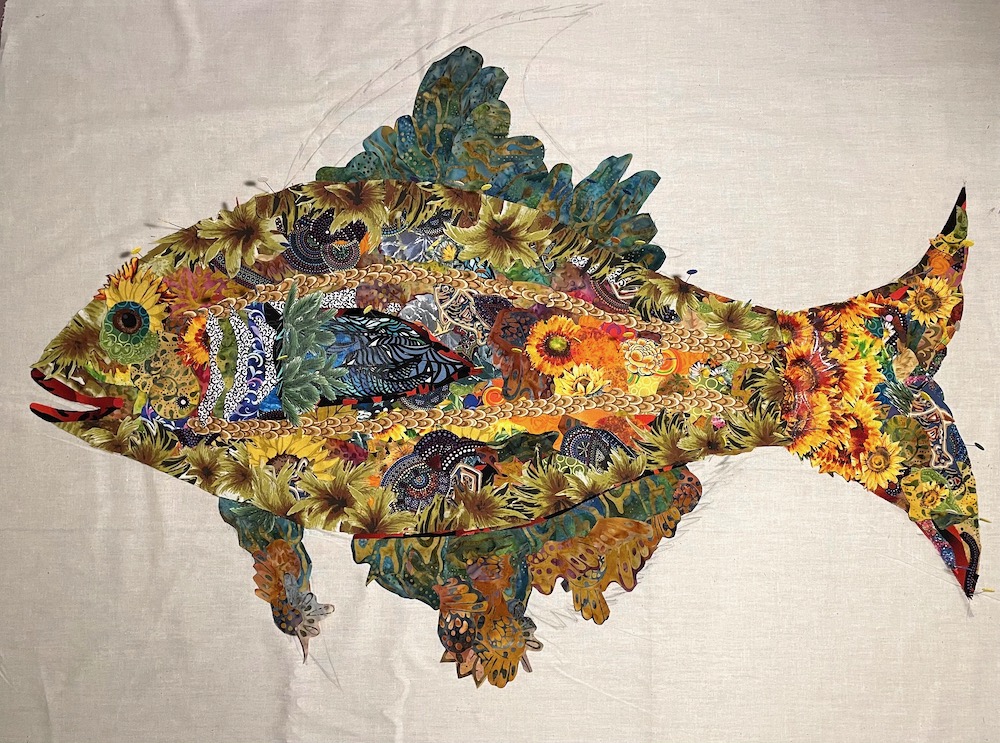
From Maribel Marrero of Cortlandt Manor, New York:
A little before the fish class was about to start we received instructions on how to download an image of the available fish templates we could use. We were also give the discretion to make our own. I had my son, Daniel, design a combination of one of Susan’s fish with a few differences (with even more changes made during the construction of the quilt).
I knew the fish had to have red lipstick but wasn’t happy with the first red fabric I chose. I later found “Walking Dead” fabric I had purchased to make a pillow case for my son, cut it up and voila, Dahlia was born. Her story quickly developed from there: she is a fish in love, getting ready to go meet her new boyfriend fish, at a dance.
She even has a birthmark (can you find it?)!
Lisa Feinberg
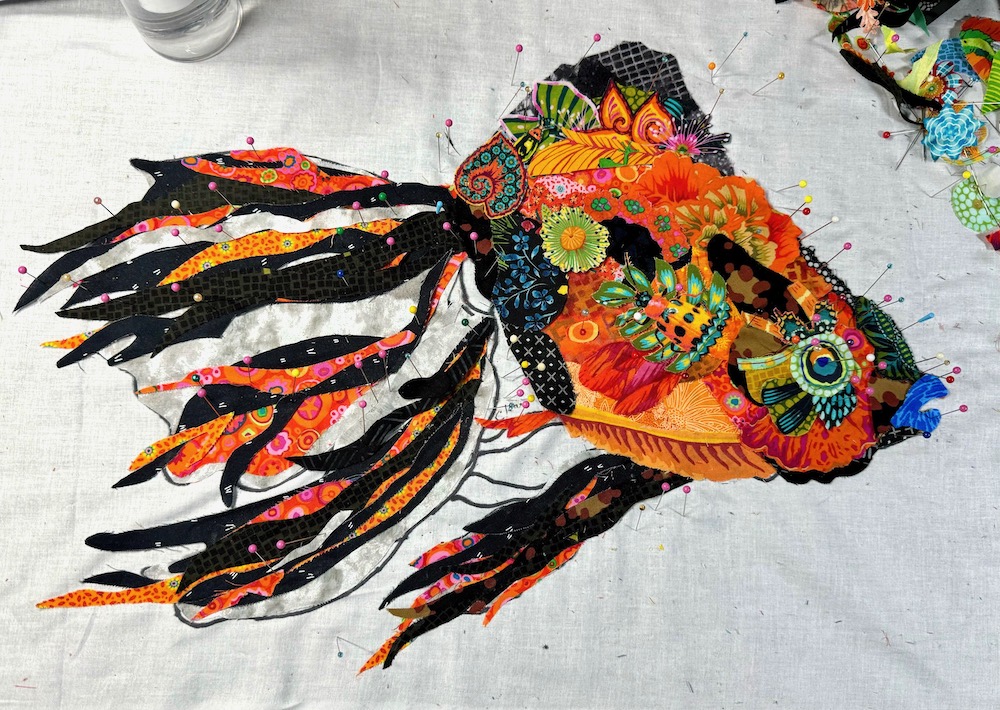
From Lisa Feinberg of Canton, GA:
My quilt isn’t finished yet. Only half of the fish is glued down currently. This is a fancy goldfish that I changed the fabrics I used a few times during making it. I wanted to make an orange and black goldfish, the flowing tail is almost finished, the tail was the easiest part.
Terri Drimel
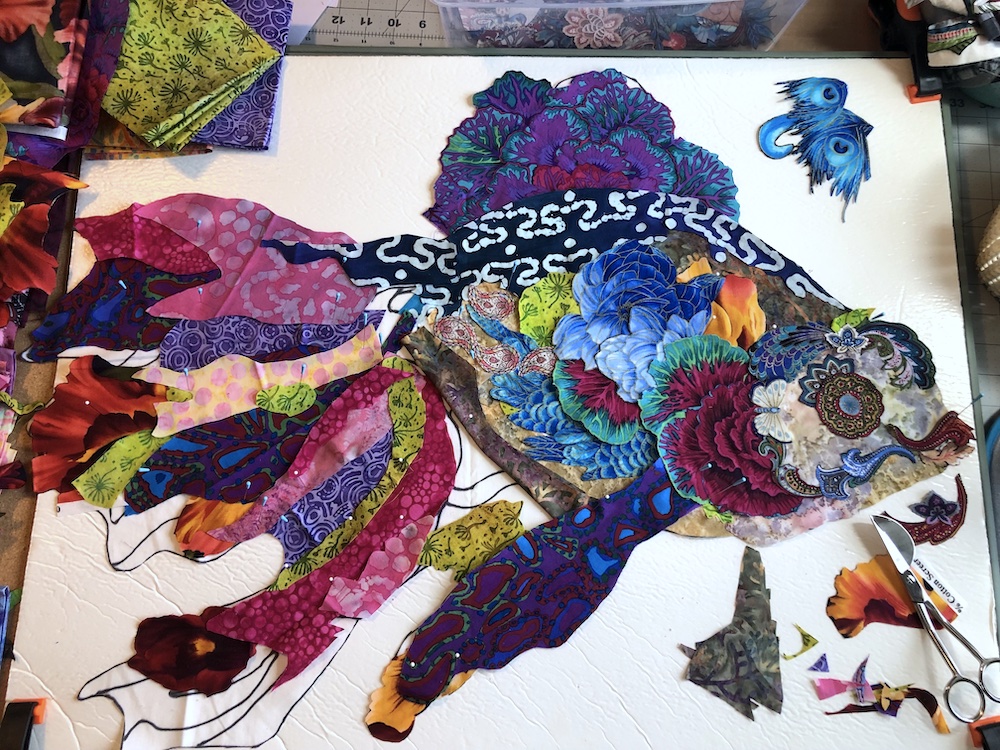
From Terri Drimel of East Central Minnesota, Center City:
I first saw another artist’s fabric collage pieces at a quilt show in 2018. When doing research on the internet, I found a few sites to learn fabric collage that often included buying “kits” but none really caught my interest until I came upon Susan’s work. The work spoke to me as having a creative spontaneity that I felt would enable me to learn to create my own work, rather than copying another person’s work.
The fish is still in progress. Her body came quickly but I have been struggling with the tail. I think I just need to keep simplifying. During the fantastical fish class, Susan recommended that our fish have a story. The story for my fish is that she lives in the Japanese garden pond where my husband and I were married. The garden is located at the college that my daughter, husband and I graduated from. She will have a Japanese name which I haven’t yet chosen.
Other Posts in this Series
Fantastical Fish Fabric Collage—February Results! Part 1
Part 2—More Fish in the Sea: Fantastical Fabric Collage, February Results!
Even More Fish in the Sea: Fantastical Fabric Collage, February Results! Part 3


Just goes to show you, fish don’t always have to “swim” in blue! Well done, ladies!